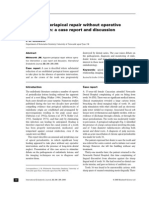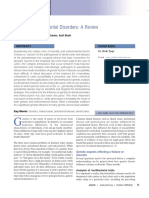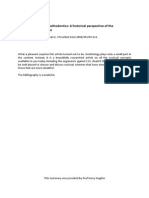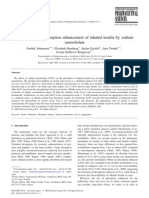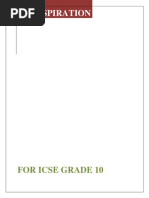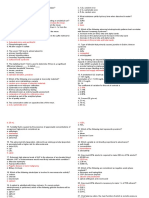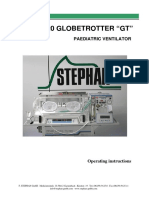0 ratings0% found this document useful (0 votes)
Etiology Maloclusion
Etiology Maloclusion
Uploaded by
Riskha Febriani Hapsariot6oto
Copyright:
© All Rights Reserved
Available Formats
Download as PDF, TXT or read online from Scribd
Download as pdf or txt
Etiology Maloclusion
Etiology Maloclusion
Uploaded by
Riskha Febriani Hapsari0 ratings0% found this document useful (0 votes)
ot6oto
Copyright
© © All Rights Reserved
Available Formats
PDF, TXT or read online from Scribd
Share this document
Did you find this document useful?
Is this content inappropriate?
ot6oto
Copyright:
© All Rights Reserved
Available Formats
Download as PDF, TXT or read online from Scribd
Download as pdf or txt
0 ratings0% found this document useful (0 votes)
Etiology Maloclusion
Etiology Maloclusion
Uploaded by
Riskha Febriani Hapsariot6oto
Copyright:
© All Rights Reserved
Available Formats
Download as PDF, TXT or read online from Scribd
Download as pdf or txt
You are on page 1/ 3
Genetics versus environment in
the aetiology of malocclusion
A. McKeever
1
drift, facilitated by interproximal and
occlusal/incisal attrition.
13
Older adults in
these well-occluded populations therefore
typically exhibit what would clinically be
described as heavily worn Class III edge-to-
edge malocclusions with a slight tendency
towards posterior crossbites. Crucially, con-
ventional features of Class II malocclusion
such as overbite and overjet are almost
always entirely absent. This and the obser-
vation that these individuals also exhibit
larger mandibular dimensions
14
presum-
ably through greater functional demands
on the masticatory apparatusprovide the
basis for the environment argument. The
fndings of Normando etal.
15
are therefore
very interesting and appear contrary to the
current thinking.
DISCUSSION
It is unfortunate, however, that the exam-
ple provided by the author shows an indi-
vidual with tooth substance loss more
characteristic of chemical erosion, rather
than attritional wear as exemplifed in
Figure1 (from my own as yet unpublished
research on a 16th century New Mexican
population). Furthermore, Normandos
own research described a two-centre cross-
sectional study where the mean ages of the
study subjects were too young to assess
the effects or otherwise of attritional wear
(12.5 and 10.2 years). The main fndings
of the paper appear to be statistically sig-
nifcant increases in anterior open bites
and Class III malocclusions in the inbred
population, which would indeed support
INTRODUCTION
The question of genetics versus environ-
ment as it relates to the aetiology of mal-
occlusion is a signifcant one, yet there
is too often a tendency to bring together
distinct clinical entities, which may have
different aetiologies, to construct an argu-
ment. This evidence-based overview aims
to breathe new life into the debate on the
phylogenesis of malocclusion through a
more open-minded and careful interpreta-
tion of the facts.
CROWDING WITH TOOTH WEAR
D. Normando writes that a study of iso-
lated Amazonian communities shows that
genetics is more important than environ-
ment in the aetiology of malocclusion and
considers an individual with crowding in
the presence of wear.
1
Most of the evidence
on occlusal variation in either historical
civilisations
2-8
or in modern pre-industrial
populations
9-12
demonstrates that the prev-
alence of malocclusion in these groups is
very low and usually coupled with high
levels of attritive tooth wear. Tooth wear
is an important element in this discussion,
as it is posited that once a Class I occlu-
sion is established during childhood, it is
maintained by a process of gradual mesial
The ongoing debate regarding the relative contributions of heredity and environment to the aetiology of malocclusion
would beneft from both a more careful interpretation of the evidence and the abandonment of the tendency to confate
under one umbrella term distinct clinical entities, which may in turn have different aetiologies. D. Normandos letter of 24
February 2012 (BDJ 2012; 212: 153) raises some interesting and surprising points, which deserve attention and comment.
the hypothesis that genetics has a more
important role than environment when all
other factors are effectively controlled. A
high prevalence of Class III malocclusion
has previously been documented in an iso-
lated archaic population
5
again contrary
to the observations in their well-occluded
contemporariesalso suggesting a genetic
explanation. The authors also found a sta-
tistically signifcant increase in Class II
malocclusions and overjet, although as
there was no signifcant increase in over-
bite it is assumed that this represents ante-
rior open bite individuals.
CONCLUSION
Perhaps it is time to appreciate the futility of
presenting the debate over heredity versus
environment in the aetiology of malocclu-
sion as a simple dichotomy. What the evi-
dence tells us is that Class II malocclusions
with increased overbites never occur in the
ancestral environment; however, within one
1
General Dental Practitioner, Whitetree Specialist
Centre, 1-3 North View, Bristol, BS6 7PU
Correspondence to: Aidan McKeever
Email: aidan@gotadsl.co.uk
Refereed Paper
Accepted 28 March 2012
DOI: 10.1038/sj.bdj.2012.465
British Dental Journal 2012; 212: 527-528
Provides an evidence-based overview of
the human occlusal arrangement as it
usually occurs in nature.
Addresses the genetics versus
environment question as it relates to the
aetiology of malocclusion.
Suggests that the confation of different
classifcations of malocclusion may stife
the debate on their phylogenesis.
I N BRI EF
O
P
I
N
I
O
N
Fig. 1 Attritional tooth wear. Note that
degree of wear is proportional to eruption
sequence (reproduced with permission from
the Duckworth Collection)
BRITISH DENTAL JOURNAL VOLUME 212 NO. 11 JUN 9 2012 527
2012 M acm illan Publishers Lim ited. A ll rights reserved.
OPINION
or two generations of adopting a modern
urban culture they are rife.
9-12
Class II ante-
rior open bites and Class III malocclusions
do occur and, as far as we know, always
have occurred in nature. Might it not be
reasonable to suppose that heredity plays a
more important role in the aetiology of the
latter two, and function/environment in the
former? It may be that the term malocclu-
sion encompasses various clinical phenom-
enaas well as variations of normalthat
occupy opposite ends of the diagnostic and
phenotypic spectrum and might therefore
be better considered unrelated for research
purposes. When it comes to comparing notes
we can then at least be sure we are talking
about the same problem.
1. Normando D. Crowding with tooth wear. Br Dent J
2012; 212: 153
2. Begg PR. Stone Age Mans Dentition. Am J Orthod
1954; 40: 298312, 373383, 462475, 517531.
3. Evensen JP, gaard B. Are malocclusions more
prevalent and severe now? A comparative study
of medieval skulls from Norway. Am J Orthod
Dentofacial Orthop 2007; 131: 710716.
4. Helm S, Pryds U. Prevalence of malocclusion in
medieval and modern Danes contrasted. Scand J
Dent Res 1979; 87: 9197.
5. Inoue N, Ito G, Kamegai T. Malocclusion and its
pathogenic factors in skeletal remains from west
Japan. J Anthropol Soc Nip 1984; 92: 1322.
6. Mohlin B, Sagne S, Thilander B. The frequency of
malocclusion and the craniofacial morphology in
a medieval population in southern Sweden. OSSA
1978; 5: 5784.
7. Varrela J. Occurrence of malocclusion in attritive
environment: a study of a skull sample from
southwest Finland. Scand J Dent Res 1990;
98: 242247.
8. Weiland FJ, Jonke E, Bantleon HP. Secular trends in
malocclusion in Austrian men. Eur J Orthod 1997;
19: 355359.
9. Corruccinni RS, Whitley LD. Occlusal variation
in a rural Kentucky community. Am J Orthod 1981;
79: 250262.
10. Corruccini R. S, Pacciani E. Occlusal variation in
Melanesians from Bougainville, Malaita, and New
Britain. Homo 1989; 33: 1522.
11. Corruccini RS, Potter RH, Dahlberg AA. Changing
occlusal variation in Pima Amerinds. Am J Phys
Anthropol 1983; 62: 317324.
12. Corruccini RS, Lee GTR. Occlusal variation
in chinese immigrants to the United Kingdom
and their off-spring. Arch Oral Biol 1984;
29: 779782.
13. Kaifu Y, Kasai K, Townsend GC, Richards LC. Tooth
wear and the design of the human dentition: a
perspective from evolutionary medicine. Am J Phys
Anthropol 2003; 122: 4761.
14. von Cramon-Taubadel N. Global human mandibular
variation refects differences in agricultural and
hunter-gatherer subsistence strategies. Proc Natl
Acad Sci USA 2011; 108: 19, 54619: 551.
15. Normando D, Faber J, Guerreiro JF, Quinto CC.
Dental occlusion in a split Amazon indigenous
population: genetics prevails over environment.
PLoS One 2011; 6: e28387.
528 BRITISH DENTAL JOURNAL VOLUME 212 NO. 11 JUN 9 2012
2012 M acm illan Publishers Lim ited. A ll rights reserved.
Reproducedwith permission of thecopyright owner. Further reproductionprohibited without permission.
You might also like
- Cleft Lip and Palate - From Origin To Treatment PDFNo ratings yetCleft Lip and Palate - From Origin To Treatment PDF547 pages
- Apparent Periapical Repair Without Operative Intervention WHitworth IEJ 2000No ratings yetApparent Periapical Repair Without Operative Intervention WHitworth IEJ 20004 pages
- Unraveling The Genetic Threads: Exploring Orthodontics Through A Genetic Lens-A ReviewNo ratings yetUnraveling The Genetic Threads: Exploring Orthodontics Through A Genetic Lens-A Review5 pages
- Unlocking The Past: The Role of Dental Analysis in ArchaeologyNo ratings yetUnlocking The Past: The Role of Dental Analysis in Archaeology13 pages
- The Rationale For Periodontal Therapy: Raul G. Caffesse, Luis F. Edith C. MorrisonNo ratings yetThe Rationale For Periodontal Therapy: Raul G. Caffesse, Luis F. Edith C. Morrison7 pages
- 08-The Heritability of Malocclusion-Part 2 The Influence of Genetics in Malocclusion PDF100% (1)08-The Heritability of Malocclusion-Part 2 The Influence of Genetics in Malocclusion PDF9 pages
- Intl J of Osteoarchaeology - 1998 - Lewis - Growing Pains The Interpretation of Stress IndicatorsNo ratings yetIntl J of Osteoarchaeology - 1998 - Lewis - Growing Pains The Interpretation of Stress Indicators6 pages
- Rehabilitacion de La Denticion Desgastada - Johansson Et Al - JOR 2008No ratings yetRehabilitacion de La Denticion Desgastada - Johansson Et Al - JOR 200819 pages
- Genetics in Pediatric Dentistry - A Review: Drifzah, DR - Divyaprahlad, DR - Priya Subramaniam, DR - Kinjal ShahNo ratings yetGenetics in Pediatric Dentistry - A Review: Drifzah, DR - Divyaprahlad, DR - Priya Subramaniam, DR - Kinjal Shah9 pages
- Odontogenic Keratocyst - A Deceptive EntityNo ratings yetOdontogenic Keratocyst - A Deceptive Entity4 pages
- Periodontology 2000 La Controversia Endodoncia Periodoncia100% (2)Periodontology 2000 La Controversia Endodoncia Periodoncia8 pages
- Dentoskeletal Features Associated With Unilateral or Bilateral Palatal Displacement of Maxillary CaninesNo ratings yetDentoskeletal Features Associated With Unilateral or Bilateral Palatal Displacement of Maxillary Canines8 pages
- Third Molars: A Dilemma! or Is It?: Clinicians' CornerNo ratings yetThird Molars: A Dilemma! or Is It?: Clinicians' Corner6 pages
- C LARSEN - Exposure To Infectious PathogensNo ratings yetC LARSEN - Exposure To Infectious Pathogens46 pages
- The Pathogenesis of Human Periodontitis An IntroductionNo ratings yetThe Pathogenesis of Human Periodontitis An Introduction3 pages
- What are the prevalence and incidence of tooth loss in the adult and elderly population in EuropeNo ratings yetWhat are the prevalence and incidence of tooth loss in the adult and elderly population in Europe14 pages
- Bendixen Et Al. - 2019 - Time Is Running Out For Sand - NatureNo ratings yetBendixen Et Al. - 2019 - Time Is Running Out For Sand - Nature3 pages
- Plaque-Related Infections: Review ArticleNo ratings yetPlaque-Related Infections: Review Article10 pages
- The Parameters To Establish A New Corneal Dystrophy: Gordon K. KlintworthNo ratings yetThe Parameters To Establish A New Corneal Dystrophy: Gordon K. Klintworth2 pages
- Association Between Morphological Features in The Cochle - 2024 - Journal of ArcNo ratings yetAssociation Between Morphological Features in The Cochle - 2024 - Journal of Arc8 pages
- Journal - Class III Malocclussion Role of Nature and Nurture 2011No ratings yetJournal - Class III Malocclussion Role of Nature and Nurture 201110 pages
- Case Report The Challenging Diagnosis of Primordial Odontogenic TumorNo ratings yetCase Report The Challenging Diagnosis of Primordial Odontogenic Tumor5 pages
- Dent. 24 34-9.: en Ortodoncia. 1 . Edición. Editorial Panamericana. MéxicoNo ratings yetDent. 24 34-9.: en Ortodoncia. 1 . Edición. Editorial Panamericana. México7 pages
- Dental Considerations in Impacted Third MolarNo ratings yetDental Considerations in Impacted Third Molar12 pages
- Occlusion For Fixed Prosthodontics - Final PDFNo ratings yetOcclusion For Fixed Prosthodontics - Final PDF16 pages
- Advances in Human PalaeopathologyFrom EverandAdvances in Human PalaeopathologyRon PinhasiNo ratings yet
- The Long Climb: From Barber-Surgeons to Doctors of Dental SurgeryFrom EverandThe Long Climb: From Barber-Surgeons to Doctors of Dental SurgeryNo ratings yet
- Molecular Etiopathogenesis of Ameloblastoma CurrentNo ratings yetMolecular Etiopathogenesis of Ameloblastoma Current5 pages
- The Endocrine Society Clinical Practice Guidelines: A Self-AssessmentNo ratings yetThe Endocrine Society Clinical Practice Guidelines: A Self-Assessment4 pages
- Profile Changes in Premolar Extraction: Alterações No Perfil em Extrações de Pré-MolaresNo ratings yetProfile Changes in Premolar Extraction: Alterações No Perfil em Extrações de Pré-Molares7 pages
- Non-Communicable Diseases and Physical InactivityNo ratings yetNon-Communicable Diseases and Physical Inactivity37 pages
- RBC Transfusion Decisions Adults - UpToDateNo ratings yetRBC Transfusion Decisions Adults - UpToDate1 page
- José Gumilla Orinoco River Charles Bonnet Parthenogenesis Aphids Pierre Louis M. de Maupertius Charles Marie de La CondamineNo ratings yetJosé Gumilla Orinoco River Charles Bonnet Parthenogenesis Aphids Pierre Louis M. de Maupertius Charles Marie de La Condamine10 pages
- M Echanisms For Absorption Enhancement of Inhaled Insulin by Sodium TaurocholateNo ratings yetM Echanisms For Absorption Enhancement of Inhaled Insulin by Sodium Taurocholate9 pages
- Routes of Drug Administration and Evaluation PHC461No ratings yetRoutes of Drug Administration and Evaluation PHC46115 pages
- Lignocaine Hydrochloride: Concord Repatriation General HospitalNo ratings yetLignocaine Hydrochloride: Concord Repatriation General Hospital3 pages
- Chapter 7: Nucleic Acids and Protein Synthesis: Section 1: DNANo ratings yetChapter 7: Nucleic Acids and Protein Synthesis: Section 1: DNA54 pages
- Stephan F-120 Globetrotter Paediatric Ventilator - User Manual PDFNo ratings yetStephan F-120 Globetrotter Paediatric Ventilator - User Manual PDF36 pages
- HUBS1105 Glenohumeral Joint and Muscles of The Shoulder Region Lectures CombinedNo ratings yetHUBS1105 Glenohumeral Joint and Muscles of The Shoulder Region Lectures Combined7 pages
- Dentin and Pulp Reactions To Caries and Operative Treatment - Biological Variables Affecting TreatNo ratings yetDentin and Pulp Reactions To Caries and Operative Treatment - Biological Variables Affecting Treat14 pages


